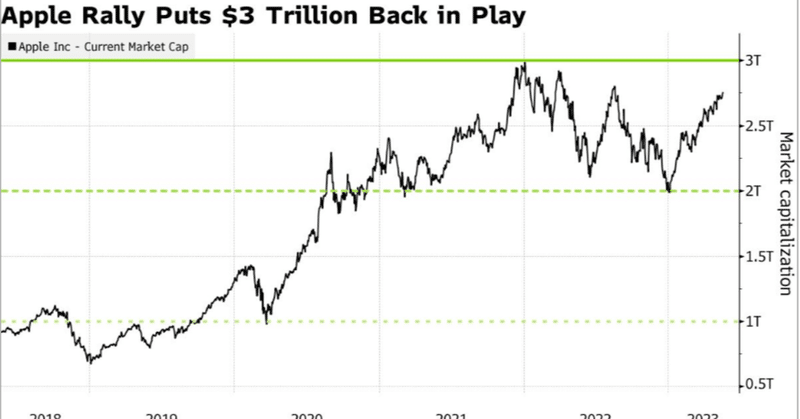
G7の多国籍企業対策はビッグテックに無風(2023年7月執筆)
先月スティグリッツ先生の寄稿で、2021年のG7で多国籍企業の利益移転(profit-shifting)対策の合意してたけど調子悪くない?って話が上がってました。先月30日にアップルの時価総額が終値で3兆ドルを突破(7/7時点で
430兆円。430兆円….orz)、エヌビディアが1兆ドルを突破(同149兆円)したように、米帝のビッグテック様々が肥大化し続ける中、それら含む多国籍企業の税逃れが問題視されています。これら多国籍企業が収めるべき税を納めずに莫大な利益を上げ、マーケットを牛耳っているとしたらそれはけしからんことであり、問題視されて当然でしょう。本記事を書くのは、決して筆者が毎度のごとく昨今の株高の波に乗れない、何なら損を拡大していることとは無関係であり、クラウド・サービスや研究開発などが含まれる、本邦のその他サービス収支の赤字が拡大している状況から、多国籍企業の自国経済に対する影響が大きい途上国だけでなく、本邦も見過ごせない問題であることを提起するものです。間違っても総合商社株やビッグテック株で儲けている諸々が憎たらしくて仕方がないことに奮起されたものではございません。

さて冒頭のG7の利益移転対策ですが、もとはG20/OECDで草案されたフレームワークでそれを適用した形にな り、「10%以上のprofit marginがある企業に適用される(pillar one)」、「最低15%のグローバル法人税 (pillar two)」の2本立てとなっております。これにより、pillar oneに該当する多国籍企業は、運営している国 の税法に従い最低で15%の法人税を納めることになります。
本題に取り掛かる前に、事の背景はというと、デジタル化が進んだ現代において従来の税制がそぐわなくなって いることです。現代のグローバル市場は、サービスを提供する土地において「実店舗を設けることが前提の経済」に沿った税制を敷いており、現地で物理的な店舗を設けずとも企業は外国にサービスを販売できることが当 たり前になりました。そこで問題になってくるのが、利益を申告するのはどこの国になるのか、という点であ り、本国かサービスを販売した国どちらといった二分法ではなく、タックスヘイブンというエンティティが利益 移転を産んでいます。現状、タックスヘイブンに利益移転することが合法であり、ここをどうにかしない限り上 記のフレームワークも机上の空論となってしまいます。
諸問題の議論は、企業のクロスボーダーの売上に対する税制、利益申告、連結のルール、タックスヘイブンが合 法となっている法制などについての理解無しには始まらないわけですが、OECDが要旨と経過をまとめてくれて おりまして、一番古いのは2015年のBEPS (base erosion and profit shifting)のまとめですね。ページ量が多いの でクロスボーダーの税制について書かれてそうなch2だけ読んでみます。ch5-8読めばテック企業の税逃れスキー ムは掴めそうな雰囲気ですが気が進まないのでいつか読むことがあればまとめます。
14. Most countries impose taxes on both income and consumption. While income taxes are levied on net income (i.e. from labour and capital) over an annual tax period, consumption taxes operate as a levy on expenditure relating to the consumption of goods and services, imposed at the time of the transaction.
15. There are a variety of forms of income and consumption taxes. Income tax is generally due on the net income realised by the taxpayer over an income period. In contrast, consumption taxes find their taxable event in a transaction, the exchange of goods and services for consideration either at the last point of sale to the final end user (retail sales tax and VAT), or on intermediate transactions between businesses (VAT) (OECD, 2011), or through levies on particular goods or services such as excise taxes, customs and import duties. Income taxes are levied at the place of source of income while consumption taxes are levied at the place of destination (i.e. the importing country).
まず第一にクロスボーダー云々はともかく、incomeとconsumption両方に課税されるのがほとんどであり、前者 はsource countryで、後者が輸入国など終点で課税されると書かれてますね。VATについてはこの後出てきます。
18. At the time CIT systems were introduced, one of their primary objectives was to act as a prepayment of personal income taxes due by the shareholders (i.e. the “gap-filling” function (Bird, 2002), also referred to as the “deferral justification”), thereby preventing potentially indefinite deferral of personal income tax (Vann, 2010). As a result, the corporate tax base was seen as a proxy for the return on equity capital. It follows that corporate taxes are generally imposed on net profits, that is receipts minus expenses. Two basic models, different in their approach but similar in their practical result, are used to assess this taxable income:
The receipts-and-outgoings system (or profit and loss method): net income is determined as the difference between all recognised income derived by a corporation in the tax period and all deductible expenses incurred by the corporation in the same tax period.
The balance-sheet system (or net-worth comparison method): net income is determined by comparing the value of the net assets in the balance sheet of the taxpayer at the end of the tax period (plus dividends distributed) with the value of the net assets in the balance sheet of the taxpayer at the beginning of the tax period.
肝心の法人税ですが、一般的に純利益に課されるもので単純に表すと
純利益 = 収入 – 費用 ですが、課税対象計算には大きく分けて2つのモデル:(1)当期net incomeから費用を引くモデル、(2)前期のB/S と比較してその差額を対象とするモデル、があるらしいです。
22. Domestic tax rules for the taxation of cross-border income generally address two situations: the taxation of outbound investments of resident companies, and the taxation of inbound investments of non-resident companies.
26. […] With respect to business income, the concept of source under domestic law often parallels the concept of permanent establishment (PE) as defined under tax treaties. Such income is typically taxed on a net basis. For practical reasons however, it may be difficult for a country to tax certain items of income derived by non-resident corporations. […] As a result, taxation at source of certain types of income (e.g. interest, royalties, dividends) derived by non-resident companies commonly occurs by means of withholding taxes at a gross rate.
29. Among those factors, the economists concluded that in general, the greatest weight should be given to “the origin of the wealth [i.e. source] and the residence or domicile of the owner who consumes the wealth”. […] In other words, the group advocated that tax jurisdiction should generally be allocated between the state of source and the state of residence depending on the nature of the income in question.
インバウンドとアウトバウンドの取引があって、それぞれどう課税されるかは異なるって話で、source country はPEの存在有無によるとされていて、後に続く話もresidence、sourceどちらの性質をもっているかっていうの が納税先を決めるドライバーになっている模様。以降もつらつらとresidence vs sourceに関連して書かれており ますが、現代経済において、二国間の税制の取り決めはほとんど(Most)が the OECD Model Tax Convention or the United Nations Model、などのモデルをベースにしており、
35. By requiring a sufficient level of economic presence, this threshold is also intended to ensure that a source country imposing tax has enforcement jurisdiction, the administrative capability to enforce its substantive jurisdiction rights over the non-resident enterprise.
36. The PE definition initially comprised two distinct thresholds: (i) a fixed place through which the business of the enterprise is wholly or partly carried on or, where no place of business can be found, (ii) a person acting on behalf of the foreign enterprise and habitually exercising an authority to conclude contracts in the name of the foreign enterprise. […] Some extensions have been made over time to address changes in business conditions.
PEっていう閾値が重要ってことでしょうかね。この後はVAT (value added taxes:付加価値税の) の話が続いて ますが、VATの課税の流れだったり色んなオプションがありますよって話であるのと、その後つづく章の前座の ような位置づけですので、VAT設計の2つのアプローチをピックアップします。VATが何の設計もなしに事業者に 課すと、売上にも課税され、商品やサービスを取得する際にもVATの負担が発生してしまうためその負担を軽減するためのメカニズムが用意されており、そのうちの一つがinvoice-credit method(インボイス方式)でもう一 つがsubstraction method(差分方式)です。前者は昨今議論が加熱している(というかインボイス制度反対の税 金払いたくない人達が騒いでいいる)インボイス制度のことであり、日本を除く多くの国がこちらの方式を取っ ています。これがクロスボーダーの取引になったとき、課税先はどこになるかというと、
52. For these reasons, there is widespread consensus that the destination principle, with revenue accruing to the country where final consumption occurs, is preferable to the origin principle from both a theoretical and practical standpoint. In fact, the destination principle is the international norm and is sanctioned by World Trade Organisation (WTO) rules.
物・サービスが消費される終点での課税が一般的のようです。物のVATとサービスのVATは勝手が違っており、 サービスのVATの取り扱いはちょいと複雑で、B2BとB2Cとで納税対象が変わっていたりと難しく、前者より文量が割かれています。
AppleやAmazonあたりの国あたりの納税額など調べたいところですが、SECのEDGARにあるのは8-kや10-kなど の財務諸表のみであり、各企業のIRサイトにcoutry-specificな財務情報があるか見に行くのも無理があり、、、 というところで本件どうにも熱量を注げず肩透かし感が否めない密度になっております。しかしながら、健全な 財政規律なくして途上国の成長は語られず、政府歳入の中心である税は途上国にとっても大変重要なファクター です。低い法人税で多国籍企業を誘致するスキームを展開している途上国からすると、G7の合意は先進国中心の ディールに映るので批判のほうが強いのは確かではあるものの、多国籍企業が然るべき法人税を現地に還元する ことの意味合いは大きいでしょう。コロンビアがラテンアメリカ諸国で多国籍企業の税に関するアコードを提案 しているように、グローバルサウス主導の動きは出てきているようです。
この記事が気に入ったらサポートをしてみませんか?
